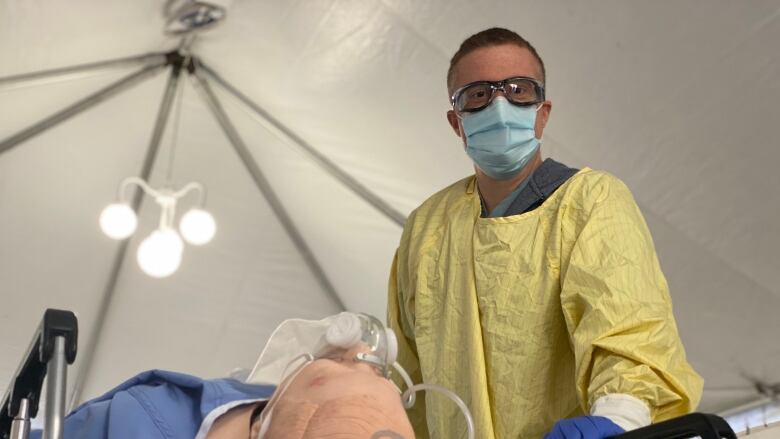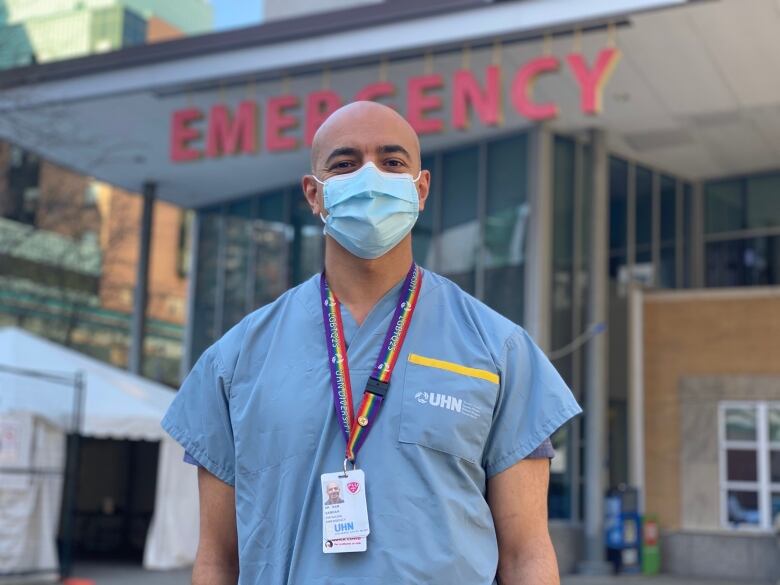Hospital staff train in new ER tents to prepare for surge in non-COVID-19 patients
Tents will help with patient flow, create space for physical distancing, UHN says

Outside Toronto General Hospital's emergency entrance, a stretcher appears quickly after a call for help.
Around a dozen health-care workers in PPE practise responding to a simulated cardiac arrest.Some are observing the process as amedical mannequinis carefully lifted onto the stretcher, CPR is performed and nurses check for a pulse.
Thissituation isn't new tohospital staff, but the environmentis;they're working in tentserected outside.
"These tents have been designed as waiting rooms and the purpose of them is to help people socially distance while waiting in the emergso they can feel safer when they come here," Dr. Alia Dharamsiexplained.The physician at theUniversity Health Network (UHN) is also thelead for the emergency department's in-situ simulation program.
Recently, hospital staff, includingregistered nurses, nurse managers and educators, doctors and even security guards, have been running through various simulations to ensure any challenges in this new care setting medical or environmental are addressed.
Even though new COVID-19 cases and hospitalizationshave beenslowly going down, UHNsays its emergency departments are still busy. As its hospitalsanticipatea surge in patients who have been delaying care, staff are coming up with ways to create more space and ensure patients feel safe.
WATCH | Talia Ricci takes us inside the new ER tents:
Last week,the team ran throughsimulations in the tent responding to a cardiac arrest and anoverdose.Dharamsi says even though the tent is meant to be a waiting area, they want to be prepared to handle any potential medical emergencies.In the training process, they usevarious tools to communicate with staff inside and practise moving the patient safety.
She says they take notes on what they observe throughout thesimulation.
"It can be as basic as the ground is uneven, which makes it difficult to push a stretcher. Or it can be as complex as how do we deliver CPR on a patient who is outside of our [emergency room]," she said.
"Then we write all of these challenges down, and we solve them one by one by one."
Protocols on how to handle variouschallenges and changes in the emergency department throughout the pandemic have been written based on training sessions like these.
Sarah McDermid-Flabbi, an advanced-practice nurse educator at UHN,says the simulations are aimed at makingboth patients and staff feel safe and supported.
"It gives us an opportunity to do things in a light-hearted way;to learn in a safe environment, to make mistakes in a safe environment," she said. McDermid-Flabbi addedshe's been amazed by the number of times the team has adapted to new protocols, and the ways it's brought her colleagues closer together.
"The pandemic has taught us to think on our feet time and time again."
The ups and downs of ER visits
Dr. Sam Sabbah,medical director of UHN's emergency departments, says at the peak of every wave of COVID-19, he sees a reduction in patients with other health issues.
"As the COVID activity comes down, people feel more comfortable seeking care for things that really they've been suffering from for a while," Sabbah said.
"I anticipate as the vaccination ramps up and people feel more safe and comfortable, we will see a surge in activity in the emergency departments for many of the conditions that have been deferred throughout."
Currently, he says, the hospitals are seeing a number of overdoses, patients experiencing mental health crises andvictims of domestic violence andchild abuse.

"All of those are the unwanted effects of being in a lockdown situation and people being confined indoors all the time," he said.
In recent weeks, there have also been ER visits due to concerns over vaccine side effects, but Sabbah says the vast majority of the symptoms are minor.
"Unfortunately, because of all the concerns around the serious side effects, it's caused a lot of distress to people who are seeking an assessment to ensure they're not having the serious side effects."
In addition to the waiting room tents, UHN and its partners have also created and expanded a virtual emergency room so people can access care from their homes and avoid a visit. But Sabbah wants people to know their emergency departments are safe.
"If you're feeling unwell, you really should come and get checked out. Many conditions have a time sensitive complication rate so the longer you wait, the more likely complications will develop. We certainly would not want that for anyone."
Despite these challenges, and the anticipated surge in non-COVID-19 patients in emergency rooms, Sabbah says he's feeling hopeful about the futureof health care in the province post-pandemic.
"It's really taught us how to work together as a system more effectively than we've ever done before."
Dharamsi anticipatesthe tents willbe ready to use within the next few weeks.
"Ideally, this will remain a tent that never has a patient in it because that means we're able to adapt our inside spaces," she said.
"But we'll be ready, if we do."













_(720p).jpg)


 OFFICIAL HD MUSIC VIDEO.jpg)
.jpg)



























































































